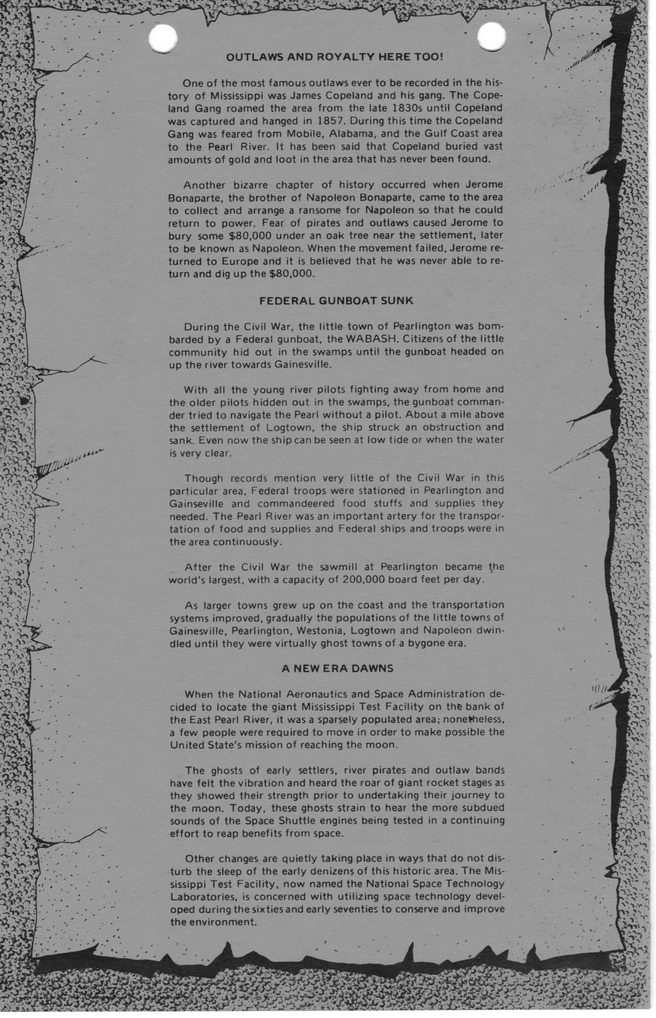This text was obtained via automated optical character recognition.
It has not been edited and may therefore contain several errors.
JQ OUTLAWS AND ROYALTY HERE TOO! c One of the most famous outlaws ever to be recorded in the history of Mississippi was James Copeland and his gang. The Copeland Gang roamed the area from the late 1830s until Copeland was captured and hanged in 1857. During this time the Copeland Gang was feared from Mobile, Alabama, and the Gulf Coast area to the Pearl River. It has been said that Copeland buried vast amounts of gold and loot in the area that has never been found. Another bizarre chapter of history occurred when Jerome Bonaparte, the brother of Napoleon Bonaparte, came to the area to collect and arrange a ransome for Napoleon so that he could return to power. Fear of pirates and outlaws caused Jerome to bury some $80,000 under an oak tree near the settlement, later to be known as Napoleon. When the movement failed, Jerome returned to Europe and it is believed that he was never able to return and dig up the $80,000. FEDERAL GUNBOAT SUNK During the Civil War, the little town of Pearlington was bombarded by a Federal gunboat, the WABASH. Citizens of the little community hid out in the swamps until the gunboat headed on up the river towards Gainesville. With all the young river pilots fighting away from home and the older pilots hidden out in the swamps, the gunboat commander tried to navigate the Pearl without a pilot. About a mile above the settlement of Logtown, the ship struck an obstruction and sank. Even now the ship can be seen at low tide or when the water is very clear. Though records mention very little of the Civil War in this particular area, Federal troops were stationed in Pearlington and Gainseville and commandeered food stuffs and supplies they needed. The Pearl River was an important artery for the transportation of food and supplies and Federal ships and troops were in the area continuously. After the Civil War the sawmill at Pearlington became \he world's largest, with a capacity of 200,000 board feet per day. As larger towns grew up on the coast and the transportation systems improved, gradually the populations of the little towns of Gainesville, Pearlington, Westonia, Logtown and Napoleon dwindled until they were virtually ghost towns of a bygone era. A NEW ERA DAWNS When the National Aeronautics and Space Administration decided to locate the giant Mississippi Test Facility on the bank of the East Pearl River, it was a sparsely populated area; nonetheless, a few people were required to move in order to make possible the United State's mission of reaching the moon. The ghosts of early settlers, river pirates and outlaw bands have felt the vibration and heard the roar of giant rocket stages as they showed their strength prior to undertaking their journey to the moon. Today, these ghosts strain to hear the more subdued sounds of the Space Shuttle engines being tested in a continuing effort to reap benefits from space. Other changes are quietly taking place in ways that do not disturb the sleep of the early denizens of this historic area. The Mississippi Test Facility, now named the National Space Technology Laboratories, is concerned with utilizing space technology developed during the sixties and early seventies to conserve and improve the environment.

Logtown National Space Technology Laboratories pamphlet (4)